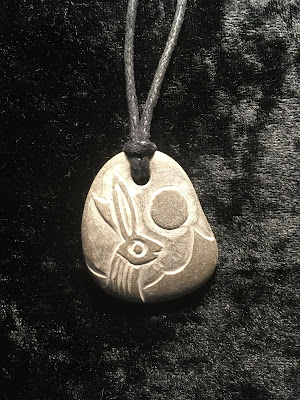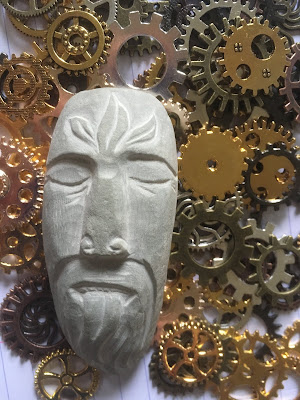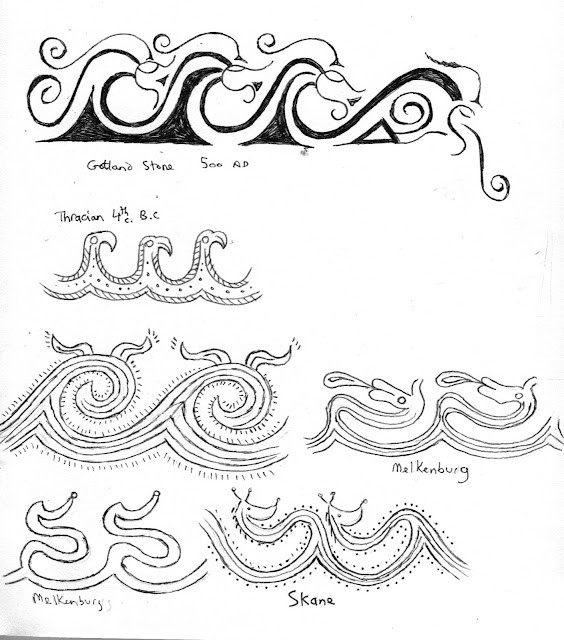I know that I hung on the wind battered tree
On that tree which no one knows
They did not comfort me with the loaf
Nor with the drinking horn,
Nine mighty songs I took*
This is how the discovery of the sacred runes is described in the Havamal, an ancient poem that tells of Odin’s self sacrifice on the world tree and how, in a state of religious ecstasy, he ‘discovered’ the runes. But what is a rune? Etymologically speaking runár was an old Germanic and Celtic word that designated magic secrets, while Gothic runa indicated a sense of a secret decision, rūn is old Irish for mystery, secret purpose, and Finnish runo refers to epic and magical chants. These appear to stem from the Proto Indo-European Reu - to roar and to whisper.
 |
| Orkney futhark |
There is little doubt that before they were transcribed runes were linguistic tools. The earliest records of symbolic runes, as we know them today, come in the form of runestaves that were in use from about 50 CE. Though the runic system mutated considerably, it was still being used in Iceland in the 1700's (The Icelandic book known as the Galdrabok details various spells and charms featuring the use of runes and runic talismen).
 |
| Page from the Galdrabok |
However there are different versions concerning the origin of the runes - one is that it developed via Roman trade routes in Germanic tribal locations, and was a system based upon Latin - another is that it developed during a period of Hellenic influence, or that it developed in the north of Italy, via Etruscan and Italic tribes, and went north. Each theory is valid, and each has its drawbacks, but I’m not going to go into them as all are fairly speculative. Perhaps the myth of how Odin hung on the world tree for nine days and nights is sufficient enough. *
 |
| Etruscan alphabet |
The Roman author Tacitus wrote about the Germanic tribes and wrote :
“Augury and divination by lot no people practice more diligently. The use of the lots is simple. A little bough is lopped off a fruit-bearing tree, and cut into small pieces; these are distinguished by certain marks, and thrown carelessly and at random over a white garment. The public questions the priest of the particular state, in private the father of the family, invokes the gods, and, with his eyes toward heaven, takes up each piece three times, and finds in them a meaning according to the mark previously impressed on them.”
We cannot be sure if the marks were runes but the passage is certainly evocative of such.
The original 24 runic symbols became known as the elder futhark (the name futhark/futhorc deriving from the first letters of the runic sequence). However younger futhark developed around the 7th c. AD from the elder. The Anglo Saxons also had their own runic alphabet too, but obviously runes mutated depending on region. In the megalithic tomb known as Maeshowe, on the island of Orkney, there is some brilliant examples of runic graffiti. Some are carved in a form known as ‘twig-runes’.
In Northumbria the runic inscriptions that survive are mainly of Christian subjects, such as the Rood poem on the sandstone cross at Ruthwell, Dumfries and Galloway. So even though their origins are most certainly pagan, they were used by Christians too.
 |
| Orkney twig runes |
Runes were also carved on more perishable material that no longer survives. They also appeared on weapons such as the spearheads from Dahmsdorf and Kovel - early examples of the symbolic power associated with the runes: just as one might engrave a wolf onto a sword to invoke the power of the wolf, so too runes invoked different meanings. They were used to protect, to give power and to curse.
Runes were often carved into staves and then reddened with sacrificial blood, thus enhancing the potency of the device. This is evidenced by certain inscriptions that appear to be meaningless barrages of repeated letters: the repetition of a particular rune was meant to enhance its power.
 |
| Kovel spearhead |
A scatter of runic poems survive to this day. Some are pretty cryptic. Sometimes they agree with each other, but not always. Below I have provided the verses of these poems beneath each rune.
1 - OE - Old English rune poem
2 - OI - Old Icelandic rune poem
3 - ON - Old Norwegian rune poem
FEHU/ FE
Wealth is a comfort to any man
yet each person
must share it out well
if he wants to win
a good name before his lord
OE
Wealth is kinsman’s quarrel
the flood-tide’s token
and necromancy’s road
gold
OI
Money/wealth causes kinsen’s quarrels;
the wolf is reared in the forest
ON
URUZ/UR
Aurochs are fierce and high-horned
the courageous beast fights with its horns
a well-known moor-treader
it is a brave creature
OE
Drizzle is the cloud's tears
and the harvest’s ruin
and the herder’s hate
Shadow
OI
Slag is from bad iron;
oft lopes the reindeer over the frozen snow
THURISAZ/THURS
Thorn is painfully sharp to any warrior
seizing it is bad,
excessively severe
for any person who lays among them
OE
Giant is women’s illness
and a cliff-dweller
and Vardhrun’s husband
Saturn
OI
Giant’s cause women’s sickness;
few are made cheerful by adversity
ANSUZ/ASS
God (Odin) is the origin of all language
wisdom’s foundation and the wise man’s comfort
and to every hero a blessing and hope
OE
God (Odin) is progenitor
and Asgard's chief
and Valhalla's leader
Jupiter
OI
Estuary is the way for most onward journeys:
and the scabbard is the sword’s
ON
RAIDO/REITH
Riding is for every man in the hall
easy and strenuous for he that sits upon
a powerful horse along the long paths
OE
Riding is sitting joyful
and a speedy trip
and the horse's toil
Journey
OI
Riding they say is for horses worst;
Reginn hammered out the best sword
ON
KENAZ/KAUN
Torch is known to each living thing by fire
radiant and bright
it usually burns where nobles rest indoors
OE
Sore is children’s illness
and a battle journey
and putrescence’s house
Whip
OI
Sore is the disfiguring of children;
adversity renders a person pale
ON
GEBO
Gift is an honour and a grace of men
a support and adornment
and for any exile
mercy and sustenance when he has no other
OE
WUNJO
Happiness he cannot enjoy who knows little woe,
pain and sorrow
and has for himself
wealth and joy
and sufficient protection too
HAGALAZ/HAGALL
Hail is whitest of corn
from heaven’s height it whirls
wind blown
it becomes water after
OE
Hail is cold seed
and a sleet shower
and snake’s illness
Hail
OI
Hail is the coldest of seeds;
christ shaped the heavens in fore times
ON
NAUTHIZ/NAUTH
Need is hard by the heart
yet for men’s sons it often becomes
a help and healing if they need it before
OE
Need is a bondswoman’s yearning
and a difficult circumstance
and drudging work
work
OI
Need renders little choice;
the naked will freeze in the frost
ON
ISA/ISS
Ice is too cold and extremely slippery
glass clear it glistens most like gems
a floor made of frost
fair in appearence
OE
Ice is a river’s bark
and a wave’s thatch
and doomed men’s downfall
ice
OI
Ice is called a bridge road;
the blind need to be led
ON
JERA/AR
Harvest is Men’s hope when god allows
- holy king of heaven
the earth to give up
fair fruits to warriors and to wretches
OE
Year/harvest is men’s bounty
and a good summer
and a full grown field
year
OI
Year/harvest is men’s bounty;
I guess that generous was Frodhi***
ON
EIHWAZ/YR
Yew is an unsmooth tree outside
hard, earthfast, fire’s keeper
underpinned with roots
a joy in the homeland
OE
Yew is a bent bow
a fragile iron
the arrow’s Farbauti ****
OI
Yew is the winter-greenest wood;
and is found wanting, when it burns, to ignite
ON
PERTH
Gaming is always play and laughter
to proud men… where warriors sit
in the beerhall happily together
OE
ALGIZ
Elk-grass most often dwells in a fen,
grows in water, harshly wounds,
marks with blood any warrior
who tries to take it
OE
SOWILO/SOL
Sun to seamen is always a hope
when they travel over the fish’s bath
until the sea-steed brings them to land
OE
Sun is the cloud’s shield
and a shining ray
and ice’s old enemy
wheel
OI
The sun is the land’s light;
I bow to holy judgement
ON
TIWAZ/TYR
Tyr is one of the signs, holds faith well
with noblemen, on a journey is always
above night’s gloom, never fails
OE
Tyr is a one-handed god
and the wolf’s left-overs
and the temple’s chief
Mars
OI
Tyr is the one-handed god;
oft will a smith be blowing
ON
BEORC/BJARKAN
Birch is fruitless, yet bears
shoots without seeds,
is pretty in its branches,
high in its spread
fair adorned
laden with leaves
touching the sky
OE
Birch is a leaf covered limb
and a slender tree
and a spritely wood
fir tree
OI
Birch is leaf-greenest of limbs;
Loki bore treachery’s fortune
ON
EIHWAZ
Steed is nobleman’s joy before heroes
a hoof-proud horse
where about it warriors
rich in stallions
exchange words
and is always a comfort to the restless
OE
MANNAZ/ MATHR
Man is clear to his kinsmen in mirth
yet each one must fail the others
since by his judgement the lord wishes
to commit the poor flesh to earth
OE
Man is man’s pleasure
and mould’s increase
and a ship's embellisher
man
OI
Man is mould’s increase;
great is the grip of the hawk
ON
LAGUZ/LOGR
Water is seemingly endless to men
if they must fare on a tilting ship
and sea-waves frighten them mightily
and the sea-steed does not heed the bridle
OE
Sea is a welling water
a wide kettle
and a fish’s field
lake
OI
Water is, when falling out of a mountain, a cascade;
and costly ornaments are of gold
ON
INGWAZ
Ing was first among the East Danes
seen by men until he later eastwards
went across the waves
the waggon sped behind them
thus the hard men named the hero
OE
OTHALA
Homeland is very dear to every man
if there rightfully and with propriety
he may enjoy wealth in his dwelling generally
OE
This list is not exhaustive, but the main runes are covered in all these poems.
You should also keep in mind that runic symbols have often been appropriated by less savoury elements of the political spectrum. The Nazis famously used the Sowilo symbol, just as they staked a claim on the swastika and perverted its significance. Today right-wing groups still like to think that Norse mythos bears something in common with the dumb racial doctrines they aspire to, but these ideas are a throw-back to Germanic nationalism of the 1800's - equally as blind and untrue as they are nowadays.
Runes also feature in loads of fantasy, and were brought into the public imagination by the fantasy author J.R.R Tolkien, who used a form of runic script for the Dwarfs. He borrowed heavily from Norse and Germanic literature for Lord Of The Rings.
Personally I like the runes, I find that they work for me. Like any form of divination or augury I use them with caution, sometimes skeptically, and never too often. I have carved them for years and they always feature at my stall as wee charms. I find many people identify with them, from all cultures and all ages, and that's the way it's meant to be.
If you enjoyed this article you can
Buy Me A Coffee
Cheers.
notes:
*
(or in Larrington’s version)
I took up the runes. screaming I took them
Then I fell back from there.
Nine mighty spells I learned from the famous son**
Of Bolthor, Bestla’s father
And I got a drink from the precious mead
Poured from Odrerir
** it is interesting to note that, in the poem quoted above, Odin takes nine mighty spells from the giants. It was also another giant, Alsvidr, who knew the secrets of the runes.
***One of great knowledge - might refer to Christ at the time but was used in relation to older pagan deities originally.
****Loki’s father - a ref to the action of the bow’s flinging the arrow.
Reference
Gods Of The Ancient Northmen - Geoges Dumèzil
Runelore - Edred Thorsson
The Rune Primer - Sweyn Plowright
Rudiments of Runelore - Stephen Pollington
Runes - Martin Findell









































